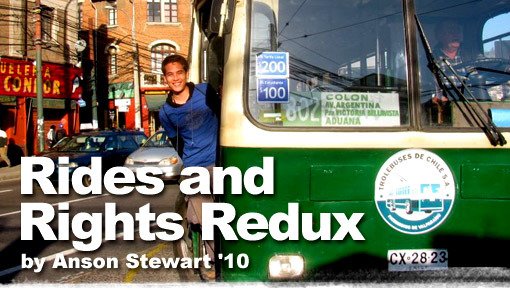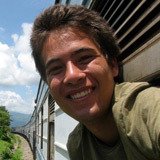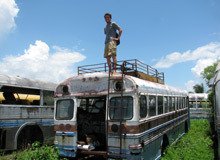Rides and Rights Redux


Upon graduating with a B.A. in urban studies and a B.S. in engineering, Anson Stewart '10 co-received the Bramson Prize for his thesis, "Rides and Rights: Organizing for Transportation Justice in Boston and Los Angeles." During his subsequent Watson year, he travelled to nine countries on two continents to explore the sale and reuse of buses purchased from the U.S. and Europe to the global south. Anson is currently pursuing an M.S. in transportation at MIT. Follow him on his blog.
Through my Lang Opportunity Scholarship at Swarthmore, I worked for two summers with the Los Angeles Bus Riders Union and the Boston T Riders Union. I was intrigued by the tactics these organizations used to transform individual experiences of transit systems into cogent critiques of capitalist logic in urban space and felt energized by the strength of their analysis. This energy carried me through the writing process for my thesis.
One suggestion from my Thesis Writers Master Class that I particularly appreciated was to think of a set of chapter titles that would challenge me as a writer. I resolved to name each of my chapters after a rail station in Los Angeles or Boston, and doing so was a fun way to structure and ground my theoretical forays.
In the year since submitting my thesis, I have travelled in Latin America and Africa investigating urban passenger transportation and how it is affected by two contrasting global flows. The first flow is the historical migration of used vehicles from industrialized countries to developing ones. Belize City and Dar es Salaam, for example, are strikingly different; yet both rely primarily on secondhand vehicles for transportation, from the United States and Japan, respectively.

In Corozal, Belize, Anson toured the Gilharry/Venus Bus Lines shop with the owner's son. Older buses, like those above, are kept at the shop for parts.
In contrast, the second flow is the propagation of a sociotechnical system, namely bus rapid transit (BRT). Pioneered in Curitiba and Bogotá, BRT is to some extent replacing nongovernmental transit operators in nearly all of the countries I visited. To understand the implications of this operational formalization, I spoke with planners, engineers, and politicians, as well as drivers, fare collectors, and passengers.
Trying to engage both technical experts and ordinary practitioners has led to diverse highlights, ranging from getting a guided tour of the new GPS bus monitoring center in Johannesburg to driving an old school bus in Panama City. In general, policymakers tend to be convinced of the technical optimality of the BRT systems they seek to implement, while everyday operators and riders seem to be more aware of significant social constraints.
This difference in perspectives has led to some contentious implementation programs and learning about these programs continually brings my thesis to mind. When I attended a talk by Columbia University sociologist Saskia Sassen in Buenos Aires about the city's new sustainable mobility plan, and later, when I listened to sociologists at a BRT research center in Santiago discuss governmentality as it relates to bus transit, I had to laugh to myself. Even after a year of travels, my thesis still seems to follow me.

In the 40 days Anson spent in Panama, he rode a total of 60 different vehicles - 43 of which were diablos rojos (former school buses). Here, he works with Luis, a pavo (literally turkey, Panamanian slang for a bus conductor), to decorate his 1986 Blue Bird school bus now operating in Panama City.
My research focus now is on how bus operators in North America can incrementally upgrade their conventional bus service by using a subset of the operating characteristics pioneered in South American BRT systems. This research is being undertaken in conjunction with the Across Latitudes and Cultures Bus Rapid Transit Center of Excellence, a research center I began working with in Santiago during my Watson year.
My Swarthmore thesis is highly relevant to my current research at MIT, which includes both Los Angeles' Metro Rapid and Boston's Silver Line as case studies. I appreciate having some familiarity with these corridors and the communities they serve because of my thesis work. Throughout the thesis-writing process, my advisor, Associate Professor of Anthropology Farha Ghannam, and the department encouraged me to define and pursue my own interests and approach. As a result, I am not surprised that the end-product of this process has remained so fresh in my mind.

Rea Vaya, Africa's first true BRT system, commenced operations in Johannesburg in August 2009. As part of his tour of its central control center, Anson got a view from one of the bus dispatch workstations.
The perspectives of the planners and policymakers with whom I am now interacting in my graduate program challenge many of the arguments from my thesis, and this has increasingly made me feel driven to revise what I submitted a year and a half ago. So while I was definitely expecting to look back on my thesis as a static, "finished" product, I did not envision such a dynamic relationship in which I am returning to reconsider the same questions. Given some of the lessons I learned at Swat, though, I guess this ongoing reflection shouldn't surprise me at all.


